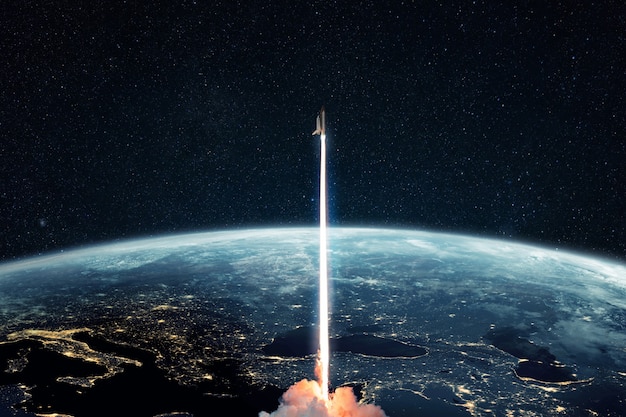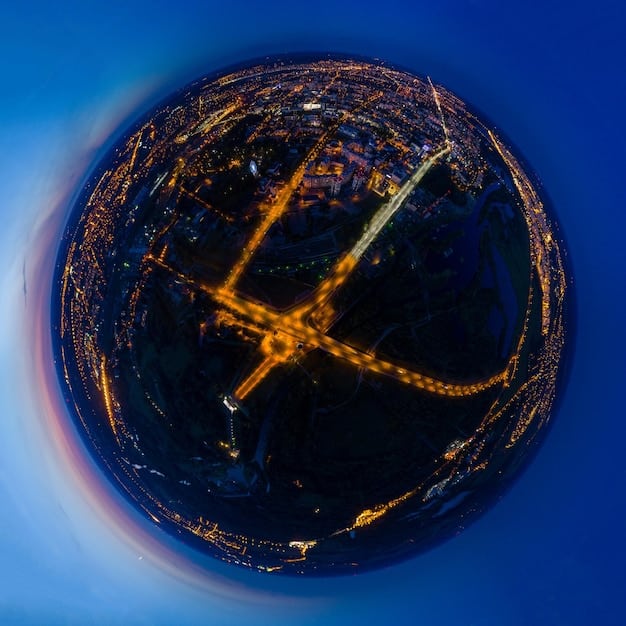Space Tech Pioneers: US Startups Leading Space Exploration

Startup Spotlight: Space Tech Pioneers focuses on US-based startups revolutionizing space exploration and commercialization through innovative technologies, ambitious projects, and strategic partnerships, driving advancements in space travel, resource utilization, and satellite technology.
The allure of space has always captivated humanity, and today, a new generation of entrepreneurs is turning this fascination into reality. The Startup Spotlight: Space Tech Pioneers highlights innovative US startups that are pushing the boundaries of space exploration and commercialization, reshaping our understanding and utilization of the cosmos.
The Rise of Commercial Space Exploration
The commercialization of space is no longer a futuristic concept; it’s a thriving industry. These US startups are at the forefront, driving innovation in areas ranging from satellite technology to space tourism.
Their work is not only advancing our capabilities in space but also creating new economic opportunities. Here are some key factors contributing to this:
- Reduced launch costs: Private companies have developed more efficient rockets, lowering the barrier to entry for space missions.
- Technological advancements: Innovations in materials science, robotics, and AI are enabling new possibilities in space exploration.
- Increased private investment: Venture capital firms are pouring money into space tech startups, fueling their growth and innovation.
These startups are not just dreaming big; they are executing ambitious plans that are changing the landscape of space exploration.
Revolutionizing Satellite Technology

One of the most significant areas of innovation is in satellite technology. US startups are developing smaller, more efficient, and more versatile satellites for various applications.
These advancements are critical for everything from communication to earth observation. Some key trends include:
- Constellations of small satellites: These networks provide global coverage for internet access and data collection.
- Advanced imaging technology: Satellites equipped with high-resolution cameras are used for environmental monitoring and urban planning.
- Hyperspectral imaging: This technology allows for detailed analysis of the Earth’s surface, with applications in agriculture and resource management.
These satellites are providing valuable data and services, enhancing our understanding of the planet and connecting people around the world.
Advancing Space Transportation
Space transportation is another area where US startups are making significant strides. They are developing new propulsion systems and reusable rockets to make space travel more accessible and affordable.
This includes:
Reusable Rockets
Companies are designing rockets that can be launched multiple times, significantly reducing the cost per launch.
Electric Propulsion
Electric propulsion systems are more efficient than traditional chemical rockets, allowing for longer and more complex missions.
Hypersonic Flight
Some startups are working on developing hypersonic aircraft that can travel to space and back, opening up new possibilities for space tourism and transportation.
These innovations are making space travel more sustainable and opening up new opportunities for exploration and commerce.

Exploring Resource Utilization in Space
The idea of extracting resources from asteroids and other celestial bodies is gaining momentum. US startups are exploring ways to mine valuable materials in space.
This could revolutionize industries on Earth and enable long-term space colonization.
Here are a few ways these projects are developing:
- Asteroid mining: Companies are developing robots and technologies to extract water, metals, and other resources from asteroids.
- Lunar resource extraction: Startups are planning missions to the Moon to mine helium-3 and other valuable materials.
- In-situ resource utilization (ISRU): This involves using resources available in space to create fuel, building materials, and other essential supplies.
Resource utilization in space could provide a sustainable source of raw materials and reduce our reliance on Earth’s resources.
Facilitating Space Tourism
Space tourism is becoming a reality, with several US startups offering opportunities for people to experience the thrill of space travel. These ventures aim to democratize access to space.
Here are some steps in the journey of space tourism:
- Suborbital flights: Companies are offering short flights that take passengers to the edge of space, allowing them to experience weightlessness and see the curvature of the Earth.
- Orbital tourism: Plans are in development to send tourists to space stations for longer stays.
- Lunar tourism: Ambitious projects aim to send tourists to the Moon in the coming years.
Space tourism not only provides a unique experience but also generates revenue that can be reinvested in further space exploration.
Navigating the Regulatory Landscape
The space industry is heavily regulated, and US startups must navigate a complex legal and regulatory landscape to operate successfully. Compliance and advocacy are key.
This includes:
- Licensing and permits: Companies need to obtain licenses from various government agencies to launch rockets, operate satellites, and conduct other activities in space.
- Space law: International treaties and national laws govern the use of space, and companies must comply with these regulations.
- Environmental regulations: Space activities can have environmental impacts, and companies must take steps to minimize these impacts.
Many startups are actively working with policymakers to shape the future of space regulations, ensuring a fair and sustainable environment for innovation and growth.
| Key Point | Brief Description |
|---|---|
| 🚀 Satellite Technology | Revolutionizing communication and earth observation with smaller, efficient satellites. |
| 🛰️ Space Transportation | Reusable rockets and electric propulsion systems making space travel more accessible. |
| ⛏️ Resource Utilization | Exploring asteroid and lunar mining for sustainable resources in space. |
| 👨🚀 Space Tourism | Offering suborbital and orbital flights for unique experiences in space. |
FAQ – Space Tech Startups
▼
Reduced launch costs, technological advancements, and increased private investment are key drivers. These factors lower barriers and fuel innovation in space ventures.
▼
Startups develop smaller, more efficient satellites in constellations. They’re used for improved communication, Earth observation, and detailed data analysis.
▼
Reusable rockets, electric propulsion, and hypersonic flights are advancing space transport. The goal is to make space travel affordable and sustainable.
▼
It provides a sustainable source of raw materials, reducing reliance on Earth’s resources. Projects include asteroid and lunar mining to boost sectors of all types.
▼
Startups offer suborbital flights to space, allowing passengers to experience weightlessness. Orbital and lunar stays may become possible in the future.
Conclusion
The US space tech startup scene is dynamic and transformative, pushing the boundaries of what’s possible in space exploration and commercialization. With innovations in satellite technology, space transportation, resource utilization, and tourism, these companies are not only shaping the future of space but also creating new opportunities for economic growth and scientific discovery.





